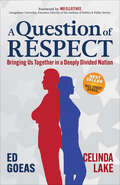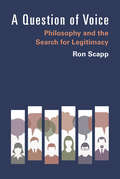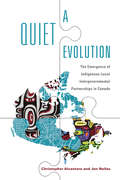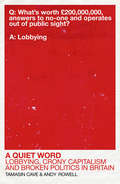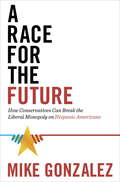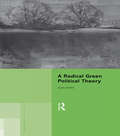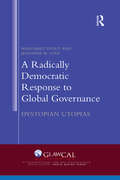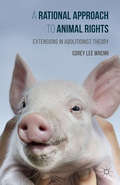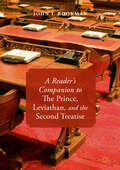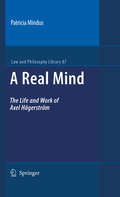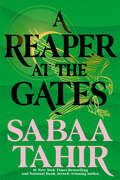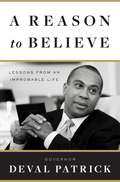- Table View
- List View
A Question of RESPECT: Bringing Us Together in a Deeply Divided Nation
by Celinda Lake Ed GoeasA Question of Respect speaks to voters who are tired of a political environment that ends in immovable stalemate, grounded by a political party’s voter base without addressing solutions or attempting to understand the opposing side.
A Question of Voice: Philosophy and the Search for Legitimacy
by Ron ScappA Question of Voice: Philosophy and the Search for Legitimacy offers an explicit and comprehensive consideration of voice as a complex of rethinking aspects of the history of philosophy through issues of power, as well as contemporary issues that include and involve the desire for and the dynamics of legitimacy, for individuals and communities. By identifying voice as a significant theme and means by which and through which we might better engage some important philosophical questions, Ron Scapp hopes to expand traditional philosophical discussion and discourse regarding questions about validity, legitimacy, empathy, and solidarity. He offers an innovative perspective that is informed and guided by multiculturalism, ethnic studies, queer studies, feminism, and thinkers and critics such as bell hooks, Barbara Christian, Angela Davis, Jacques Derrida, Michel Foucault, among others. A Question of Voice is an American investigation, but also suggests questions that emanate from contemporary continental thought as well as issues that arise from transnational perspectives—an approach that is motived by doing philosophy in an age of multiculturalism.
A Quiet Death in Italy
by Tom Benjamin'The locale is brought to life . . . the plot keeps you guessing' The Times'A slow-burning, tense and brooding thriller' The Herald Scotland___'Tom Benjamin's debut novel blows the lid off a political cauldron in which Leftist agitators, property moguls, the police and city elders struggle for survival and dominance' Daily Mail'It's an immensely promising debut, which leaves the reader feeling they really know the city.' Morning Star________Bologna: city of secrets, suspicion . . . and murderWhen the body of a radical protestor is found floating in one of Bologna's underground canals, it seems that most of the city is ready to blame the usual suspects: the police.But when private investigator Daniel Leicester, son-in-law to the former chief of police, receives a call from the dead man's lover, he follows a trail that begins in the 1970s and leads all the way to the rotten heart of the present-day political establishment.Beneath the beauty of the city, Bologna has a dark underside, and English detective Daniel must unravel a web of secrets, deceit and corruption - before he is caught in it himself.A dark and atmospheric crime thriller set in the beautiful Italian city of Bologna, perfect for fans of Donna Leon, Michael Dibdin and Philip Gwynne Jones.
A Quiet Death in Italy (Daniel Leicester #1)
by Tom Benjamin'The locale is brought to life . . . the plot keeps you guessing' The Times'A slow-burning, tense and brooding thriller' The Herald Scotland___'Tom Benjamin's debut novel blows the lid off a political cauldron in which Leftist agitators, property moguls, the police and city elders struggle for survival and dominance' Daily Mail'It's an immensely promising debut, which leaves the reader feeling they really know the city.' Morning Star________Bologna: city of secrets, suspicion . . . and murderWhen the body of a radical protestor is found floating in one of Bologna's underground canals, it seems that most of the city is ready to blame the usual suspects: the police.But when private investigator Daniel Leicester, son-in-law to the former chief of police, receives a call from the dead man's lover, he follows a trail that begins in the 1970s and leads all the way to the rotten heart of the present-day political establishment.Beneath the beauty of the city, Bologna has a dark underside, and English detective Daniel must unravel a web of secrets, deceit and corruption - before he is caught in it himself.A dark and atmospheric crime thriller set in the beautiful Italian city of Bologna, perfect for fans of Donna Leon, Michael Dibdin and Philip Gwynne Jones.
A Quiet Death in Italy (Daniel Leicester #1)
by Tom Benjamin'The locale is brought to life . . . the plot keeps you guessing' The TimesBologna: city of secrets, suspicion . . . and murderWhen the body of a radical protestor is found floating in one of Bologna's underground canals, it seems that most of the city is ready to blame the usual suspects: the police.But when private investigator Daniel Leicester, son-in-law to the former chief of police, receives a call from the dead man's lover, he follows a trail that begins in the 1970s and leads all the way to the rotten heart of the present-day political establishment.Beneath the beauty of the city, Bologna has a dark underside, and English detective Daniel must unravel a web of secrets, deceit and corruption - before he is caught in it himself.A dark and atmospheric crime thriller set in the beautiful Italian city of Bologna, perfect for fans of Donna Leon, Michael Dibdin and Philip Gwynne Jones.
A Quiet Evolution: The Emergence of Indigenous-Local Intergovernmental Partnerships in Canada
by Christopher Alcantara Jen NellesMuch of the coverage surrounding the relationship between Indigenous communities and the Crown in Canada has focused on the federal, provincial, and territorial governments. Yet it is at the local level where some of the most important and significant partnerships are being made between Indigenous and non-Indigenous peoples. In A Quiet Evolution, Christopher Alcantara and Jen Nelles look closely at hundreds of agreements from across Canada and at four case studies drawn from Ontario, Quebec, and Yukon Territory to explore relationships between Indigenous and local governments. By analyzing the various ways in which they work together, the authors provide an original, transferable framework for studying any type of intergovernmental partnership at the local level. Timely and accessible, A Quiet Evolution is a call to politicians, policymakers and citizens alike to encourage Indigenous and local governments to work towards mutually beneficial partnerships.
A Quiet Word: Lobbying, Crony Capitalism and Broken Politics in Britain
by Tamasin Cave Andy RowellQ. What’s worth £2,000,000,000, answers to no-one and operates out of public sight? A. Britain’s influence industry The corporate takeover of democracy is no conspiracy theory – it’s happening, and it affects every aspect of our lives: the food we eat, the places we live, the temperature of our planet, how we spend our money and how our money is spent for us. And much more. A Quiet Word shows just how effectively the voice of public interest is being drowned out by the word in the ear from the professional persuaders of the lobbying industry. And if you’ve never heard about them, that’s because the most effective lobbying goes unnoticed. A Quiet Word shines the brightest of lights into one of the darkest and least-understood corners of our political culture. It is essential, urgent, authoritative reading for anyone interested in our democracy and where this country is heading. And by showing how influence is constructed, it puts power back in your hands.
A Quietist Jihadi
by Joas WagemakersSince 9/11, the Jordanian Abu Muhammad al-Maqdisi (b. West Bank, 1959) has emerged as one of the most important radical Muslim thinkers alive today. While al-Maqdisi may not be a household name in the West, his influence amongst like-minded Muslims stretches across the world from Jordan - where he lives today - to Southeast Asia. His writings and teachings on Salafi Islam have inspired terrorists from Europe to the Middle East, including Abu Mus'ab al-Zarqawi, the former leader of al-Qa'ida in Iraq, and Ayman al-Zawahiri, Osama Bin Laden's successor as the head of al-Qa'ida Central. This groundbreaking book, which is the first comprehensive assessment of al-Maqdisi, his life, ideology, and influence, is based on his extensive writings and those of other jihadis, as well as on interviews that the author conducted with (former) jihadis, including al-Maqdisi himself. It is a serious and intense work of scholarship that uses this considerable archive to explain and interpret al-Maqdisi's particular brand of Salafism. More broadly, the book offers an alternative, insider perspective on the rise of radical Islam, with a particular focus on Salafi opposition movements in Saudi Arabia and Jordan.
A Quietist Jihadi: The Ideology and Influence of Abu Muhammad Al-maqdisi
by Joas WagemakersSince 9/11, the Jordanian Abu Muhammad al-Maqdisi (b. West Bank, 1959) has emerged as one of the most important radical Muslim thinkers alive today. While al-Maqdisi may not be a household name in the West, his influence amongst like-minded Muslims stretches across the world from Jordan - where he lives today - to Southeast Asia. His writings and teachings on Salafi Islam have inspired terrorists from Europe to the Middle East, including Abu Mus'ab al-Zarqawi, the former leader of al-Qa'ida in Iraq, and Ayman al-Zawahiri, Osama Bin Laden's successor as the head of al-Qa'ida Central. This groundbreaking book, which is the first comprehensive assessment of al-Maqdisi, his life, ideology, and influence, is based on his extensive writings and those of other jihadis, as well as on interviews that the author conducted with (former) jihadis, including al-Maqdisi himself. It is a serious and intense work of scholarship that uses this considerable archive to explain and interpret al-Maqdisi's particular brand of Salafism. More broadly, the book offers an alternative, insider perspective on the rise of radical Islam, with a particular focus on Salafi opposition movements in Saudi Arabia and Jordan.
A Race Is a Nice Thing to Have: A Guide to Being a White Person or Understanding the White Persons in Your Life
by Janet E. HelmsFor racism to disappear in the United States, White people must take the responsibility for ending it. For them to assume that responsibility, they must become aware of how racism hurts White people and consequently, how ending it serves White people's best interests. Moreover, this awareness not only must be accompanied by enhanced abilities to recognize the many faces of racism, but also by the discovery of options to replace it.
A Race for the Future
by Mike GonzalezA landmark work examining the impact of Hispanic immigration on American politics, with a blueprint for what conservatives must do to recapture the American electorate. Since 1965, millions of people have come to this country from Latin America and the Caribbean, seeking freedom and the chance to make a better life. Now accounting for more than 16 percent of the population, Hispanics have emerged as a decisive voting bloc that overwhelmingly skews liberal as they influence pivotal electoral races. But it doesn't have to be that way forever. In A Race for the Future, Mike Gonzalez describes what the term Hispanic means, correcting the erroneous assumption that it is a homogenous group and presenting an un- varnished look at the challenges each nationality--Mexican, Puerto Rican, Dominican, and many others--faces in America. Despite their growing political power, Hispanics have largely been kept separate from mainstream America, and many of them are consigned to an underclass status. A Race for the Future reveals exactly how bureaucratic decisions that encourage public assistance and discourage assimilation hinder Hispanics and allow them to be politically monopolized by progressives. Gonzalez shows how conservatives can begin to reverse this damaging trajectory by supporting policies that would help Hispanics thrive--education choice, family values, and financial freedom. By returning to their core values of community, industry, and independence, conservatives can actively court the vital Hispanic vote. The fate of too many key battleground states, from Texas to Florida--analyzed in depth here--depends on the Right's ability to successfully do just that.A powerful take on a rapidly changing and diverse community, A Race for the Future is a much-needed course correction on how our country can successfully enable Hispanics to flourish while standing firm on our principles.
A Race to the Bottom of Crazy: Dispatches from Arizona
by Richard GrantThe bestselling author of Dispatches from Pluto and The Deepest South of All turns his sharp wit and observational powers on the epicenter of America&’s most divisive issues: Arizona.When Richard Grant and his wife moved with their four-year-old daughter back to Tucson, Arizona, where the couple first met, he expected to easily rekindle his love of the region. Instead, he found a housing market gone haywire, rampant election conspiracies, and right-wing political violence alarmingly close to his home and family. Undocumented immigration was surging, and the state was also on the front lines of climate change, breaking heat and drought records, and running out of long-term water supplies. Under these circumstances, Grant wondered how he might raise a happy, well-adjusted child who believes in the future. Yet these concerns weren&’t keeping people away: Arizona was simultaneously experiencing some of the nation&’s highest population growth. In A Race to the Bottom of Crazy, Grant mixes memoir, research, and reporting in a quest to understand what makes Arizona such a confounding and irresistible place. He visits the world&’s largest machine-gun shoot; takes a sunset boat cruise with a US Congressman and a group of far-right patriots; rides through the desert with a Border Patrol agent; and goes camping with his family in breathtaking mountain ranges that rise out of the desert like islands in the sky. Interspersed with these adventures are recollections of his previous stint in the state, including his friendship with cult writer Charles Bowden and years living off the grid with smugglers, dope farmers, and outlaws on the Mexican border. Ultimately, Grant arrives at the conclusion that Arizona has always been a scattershot improvisation, with bizarre and extreme behavior in its DNA. This book is an entertaining, illuminating, and essential guide to understanding modern America at its most overheated.
A Radical Green Political Theory (Routledge Innovations in Political Theory #1)
by Alan CarterThis volume is the first systematic, comprehensive and cogent environmental political philosophy. It exposes the relationships between the ever-worsening environmental crises, the nature of prevailing economic structures and the role of the modern state and concludes that the combination of these factors is driving humanity towards destruction.Innovative, provocative and cutting-edge, A Radical Green Political Theory will be of enormous value to all those with an interest in the environment, political theory and moral and political philosophy.
A Radically Democratic Response to Global Governance: Dystopian Utopias (Transnational Law and Governance)
by Margaret Stout Jeannine M. LoveThis book presents a critique of dominant governance theories grounded in an understanding of existence as a static, discrete, mechanistic process, while also identifying the failures of theories that assume dynamic alternatives of either a radically collectivist or individualist nature. Relationships between ontology and governance practices are established, drawing upon a wide range of social, political, and administrative theory. Employing the ideal-type method and dialectical analysis to establish meanings, the authors develop a typology of four dominant approaches to governance. The authors then provide a systematic analysis of each governance approach, thoroughly unpacking and critiquing each one and exploring the relationships and movements among them that engender reform and revolution as well as retrenchment and obfuscation of power dynamics. After demonstrating that each governance approach has fatal flaws within a diverse global context, the authors propose an alternative they call Integrative Governance. As a synthesis of the ideal-types, Integrative Governance is neither individualist nor collectivist, while still maintaining the dynamic character required to accommodate responsiveness to cultural contexts.
A Rage for Order: The Middle East in Turmoil, from Tahrir Square to ISIS
by Robert F. WorthThe definitive work of literary journalism on the Arab Spring and its troubled aftermathIn 2011, a wave of revolution spread through the Middle East as protesters demanded an end to tyranny, corruption, and economic decay. From Egypt to Yemen, a generation of young Arabs insisted on a new ethos of common citizenship. Five years later, their utopian aspirations have taken on a darker cast as old divides reemerge and deepen. In one country after another, brutal terrorists and dictators have risen to the top. A Rage for Order is the first work of literary journalism to track the tormented legacy of what was once called the Arab Spring. In the style of V. S. Naipaul and Lawrence Wright, the distinguished New York Times correspondent Robert F. Worth brings the history of the present to life through vivid stories and portraits. We meet a Libyan rebel who must decide whether to kill the Qaddafi-regime torturer who murdered his brother; a Yemeni farmer who lives in servitude to a poetry-writing, dungeon-operating chieftain; and an Egyptian doctor who is caught between his loyalty to the Muslim Brotherhood and his hopes for a new, tolerant democracy. Combining dramatic storytelling with an original analysis of the Arab world today, A Rage for Order captures the psychic and actual civil wars raging throughout the Middle East, and explains how the dream of an Arab renaissance gave way to a new age of discord.
A Rage for Order: The Middle East in Turmoil, from Tahrir Square to Isis
by Robert F. WorthA New York Times Notable Book of 2016 One of the Best Nonfiction Books of 2016,Publishers Weekly In 2011, a wave of revolution spread through the Middle East as protesters demanded an end to tyranny, corruption, and economic decay. From Egypt to Yemen, a generation of young Arabs insisted on a new ethos of common citizenship. Their bravery and idealism stirred observers around the world and led militant jihadis to worry that they had been superseded by a new and peaceful uprising. Five years later, the utopian aspirations of 2011 have darkened. In one country after another, brutal terrorists and dictators have risen to the top as old divides reemerge and deepen. Egypt has become a more repressive police state than ever before; Libya, Syria, and Yemen endure civil war; and the extremists of ISIS have spread chaos and carnage across the region and beyond it. A Rage for Order tracks the tormented legacy of what was once called the Arab Spring. Writing with bold literary ambition, the distinguished New York Times correspondent Robert F. Worth introduces a riveting cast of characters. We meet a Libyan rebel who must decide whether to kill the torturer who murdered his brother; a Yemeni farmer who lives in servitude to a poetry-writing, dungeon-operating chieftain; two young Syrian women whose close friendship devolves into enmity as their sects go to war; and an Egyptian doctor who is caught between his loyalty to the Muslim Brotherhood and his hopes for a new, tolerant democracy. In a final chapter, Worth tells the moving story of the two eighty-something statesmen whose unlikely camaraderie allowed Tunisia to escape its neighbors’ worst fates. Combining dramatic storytelling with an original analysis of the Arab world today, A Rage for Order captures the psychic and actual civil wars raging throughout the Middle East and explains how the dream of an Arab renaissance gave way to a new age of discord.
A Raid on the Red Sea: The Israeli Capture of the Karine A
by Amos GilboaA Raid on the Red Sea is the thrilling, real-life tale of illegal gun-running in the Middle East. In this firsthand account, Amos Gilboa gives the harrowing details of the secret close-working relations between Israeli and American intelligence in the seizure of the Karine A ship, the most successful Israeli intelligence operation since the legendary Entebbe hostage rescue. At 0400 hours, January 3, 2002, two fast boats of Israel&’s naval commando unit closed in on the stern of the Palestinian Authority&’s Karine A. The Iranian Islamic Revolutionary Guard Corps had clandestinely loaded its cargo: fifty-six tons of high-grade, long-range weapons destined for the Gaza Strip. The Israelis&’ plan to seize it went awry when they found nothing but a confused group of Egyptians, Jordanians, and Palestinians. Had they boarded the wrong ship? Was there going to be an international incident disgracing Israel? This drama has more than its share of plot twists. The story&’s hero, a low-level female intelligence analyst, was the first to grasp the grave danger posed by the Karine A. Analyzing piles of disinformation, she kept on the scent of the ship, tracking it from Egypt to Sudan to Dubai. Only through the joint efforts of Israeli and U.S. naval intelligence, Mossad and the CIA, was the ship stopped and calamity averted. Seizing the ship led to a fateful reorientation of U.S. policy regarding the Middle East with consequences to this day, from the Israeli-Palestinian conflict to the 2020 assassination of Islamic Revolutionary Guard Corps Quds Force chief Qasem Soleimani.
A Rational Approach to Animal Rights: Extensions in Abolitionist Theory
by Corey WrennApplying critical sociological theory, this book explores the shortcomings of popular tactics in animal liberation efforts. Building a case for a scientifically-grounded grassroots approach, it is argued that professionalized advocacy that works in the service of theistic, capitalist, patriarchal institutions will find difficulty achieving success.
A Reader’s Companion to The Prince, Leviathan, and the Second Treatise
by John T. BookmanMachiavelli, Hobbes, and Locke each sought a new foundation for political order. This book serves as a reader's companion to Machiavelli’s The Prince, Hobbes’s Leviathan, and Locke’s Second Treatise written for graduate students and scholars seeking a fuller understanding of these classic texts. How do these philosophers respond to perennial questions such as why anyone is ever obligated to obey a government and whether there are any limits to such an obligation. In this book, Bookman begins by sorting out the hermeneutical controversy between textualists and contextualists, offers a chapter-by-chapter commentary on the texts punctuated by questions for the reader’s reflection, and finally suggests a firmer foundation for a theory of political obligation than Hobbes’s and Locke’s consent theories. Also included are bibliographical essays keyed to select bibliographies, providing readers with a wide-ranging, critical review of the secondary literature. Intended to be read alongside the primary work, the work is a full intellectual, critical, and bibliographical history, as well as a fresh examination of three classic texts in political theory and philosophy.
A Ready and Resilient Workforce for the Department of Homeland Security
by Institute of Medicine Board on Health Sciences Policy Committee on the Department of Homeland Security Workforce ResilienceThe responsibilities of the Department of Homeland Security (DHS) range from preventing foreign and domestic terrorist attacks; securing the nation's borders; safeguarding transportation systems; responding to natural disasters; nuclear detection; and more. Created in 2002 from a merger that rapidly incorporated parts of eight cabinet departments and 22 government agencies, DHS has struggled to integrate its numerous components and their unique cultures. While DHS is very accomplished at performing its many missions, the nature of the DHS work environment is inherently stressful, and employees suffer from low morale. A Ready and Resilient Workforce for the Department of Homeland Security: Protecting America's Front Line reviews current workforce resilience efforts, identifies gaps, and provides recommendations for a 5-year strategy to improve DHSTogether, the current DHS workforce resilience program. This report stresses the importance of strong leadership, communication, measurement, and evaluation in the organization and recommends content for a 5-year plan that will promote centralized strategic direction and resource investment to improve readiness and resilience at the department. While all DHS component agencies share a common mission, each have distinct roles with different stressors attached, making implementation of an organization-wide resilience or wellness program difficult. The recommendations of A Ready and Resilient Workforce for the Department of Homeland Security outline how DHS can focus its efforts on creating a common culture of workforce readiness and resilience, while recognizing the distinct, proud, celebrated cultures of its component agencies.
A Real Mind: The Life and Work of Axel Hägerström (Law and Philosophy Library #87)
by Patricia MindusThis comprehensive presentation of Axel Hägerström (1868-1939) fills a void in nearly a century of literature, providing both the legal and political scholar and the non-expert reader with a proper introduction to the father of Scandinavian realism. Based on his complete work, including unpublished material and personal correspondence selected exclusively from the Uppsala archives, A Real Mind follows the chronological evolution of Hägerström's intellectual enterprise and offers a full account of his thought. The book summarizes Hägerström's main arguments while enabling further critical assessment, and tries to answer such questions as: If norms are neither true nor false, how can they be adequately understood on the basis of Hägerström's theory of knowledge? Did the founder of the Uppsala school uphold emotivism in moral philosophy? What consequences does such a standpoint have in practical philosophy? Is he really the inspiration behind Scandinavian state absolutism?A Real Mind places the complex web of issues addressed by Hägerström within the broader context of 20th century philosophy, stretching from epistemology to ethics. His philosophy of law is examined in the core chapters of the book, with emphasis on the will-theory and the relation between law and power. The narrative is peppered with vignettes from Hägerström's life, giving an insightful and highly readable portrayal of a thinker who put his imprint on legal theory. The appendix provides a selected bibliography and a brief synopsis of the major events in his life, both private and intellectual.
A Real Model of Transitional Growth and Competitiveness in China
by Leslie Lipschitz Geneviève Verdier Céline RochonA report from the International Monetary Fund.
A Real Right to Vote: How a Constitutional Amendment Can Safeguard American Democracy
by Richard L. HasenWhy it's time to enshrine the right to vote in the ConstitutionThroughout history, too many Americans have been disenfranchised or faced needless barriers to voting. Part of the blame falls on the Constitution, which does not contain an affirmative right to vote. The Supreme Court has made matters worse by failing to protect voting rights and limiting Congress&’s ability to do so. The time has come for voters to take action and push for an amendment to the Constitution that would guarantee this right for all.Drawing on troubling stories of state attempts to disenfranchise military voters, women, African Americans, students, former felons, Native Americans, and others, Richard Hasen argues that American democracy can and should do better in assuring that all eligible voters can cast a meaningful vote that will be fairly counted. He shows how a constitutional right to vote can deescalate voting wars between political parties that lead to endless rounds of litigation and undermine voter confidence in elections, and can safeguard democracy against dangerous attempts at election subversion like the one we witnessed in the aftermath of the 2020 presidential election.The path to a constitutional amendment is undoubtedly hard, especially in these polarized times. A Real Right to Vote explains what&’s in it for conservatives who have resisted voting reform and reveals how the pursuit of an amendment can yield tangible dividends for democracy long before ratification.
A Reaper at the Gates (An Ember in the Ashes #3)
by Sabaa TahirBOOK THREE IN THE NEW YORK TIMES BESTSELLING SERIES"Thrilling and hard to put down, readers will absolutely devour Tahir's latest." --BuzzFeedAn Entertainment Weekly Summer Reads pick!"The perfect summer read." --The Washington PostThe highly anticipated third book in #1 New York Times bestselling author Sabaa Tahir's EMBER QUARTET.Beyond the Martial Empire and within it, the threat of war looms ever larger.Helene Aquilla, the Blood Shrike, is desperate to protect her sister's life and the lives of everyone in the Empire. But she knows that danger lurks on all sides: Emperor Marcus, haunted by his past, grows increasingly unstable and violent, while Keris Veturia, the ruthless Commandant, capitalizes on the Emperor's volatility to grow her own power--regardless of the carnage she leaves in her path. Far to the east, Laia of Serra knows the fate of the world lies not in the machinations of the Martial court, but in stopping the Nightbringer. But in the hunt to bring him down, Laia faces unexpected threats from those she hoped would help her, and is drawn into a battle she never thought she'd have to fight. And in the land between the living and the dead, Elias Veturius has given up his freedom to serve as Soul Catcher. But in doing so, he has vowed himself to an ancient power that demands his complete surrender--even if that means abandoning the woman he loves.
A Reason to Believe: Lessons from an Improbable Life
by Deval Patrick"I've simply seen too much goodness in this country--and have come so far in my own journey--not to believe in those ideals, and my faith in the future is sometimes restored under the darkest clouds." --Governor Deval Patrick. In January 2007, Deval Patrick became the first black governor of the state of Massachusetts, one of only two black governors elected in American history. But that was just one triumphant step in a long, improbable journey that began in a poor tenement on the South Side of Chicago. From a chaotic childhood to an elite boarding school in New England, from a sojourn doing relief work in Africa to the boardrooms of Fortune 500 companies, and then to a career in politics, Patrick has led an extraordinary life. In this heartfelt and inspirational book, he pays tribute to the family, friends, and strangers who, through words and deeds, have instilled in him transcendent lessons of faith, perseverance, and friendship. In doing so, he reminds us of the power of community and the imperative of idealism. With humility, humor, and grace, he offers a road map for attaining happiness, empowerment, and success while also making an appeal for readers to cultivate those achievements in others, to feel a greater stake in this world, and to shape a life worth living. Warm, nostalgic, and inspirational, A Reason to Believe is destined to become a timeless tribute to a uniquely American odyssey and a testament to what is possible in our lives and our communities if we are hopeful, generous, and resilient. GOVERNOR DEVAL PATRICK is donating a portion of the proceeds from A REASON TO BELIEVE to A Better Chance, a national organization dedicated to opening the doors to greater educational opportunities for young people of color. To learn more, visit www.abetterchance.org.
